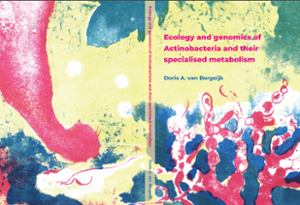Proefschrift
Ecology and genomics of Actinobacteria and their specialised metabolism
Filamentous Actinobacteria, such as Streptomyces, produce a plethora of chemically diverse bioactive metabolites that have found applications across medicine, agriculture and biotechnology.
- Auteur
- Bergeijk, D.A. van
- Datum
- 19 oktober 2022
- Links
- Thesis in Leiden Repository

Yet, the vast majority of the biosynthetic potential of Actinobacteria remains uncharacterised, largely because their biosynthetic gene clusters (BGCs) are poorly expressed in the laboratory, preventing the discovery of the cognate natural products. Additionally, only a narrow band of environments and a few taxonomic groups have been explored for gifted Actinobacteria. In this thesis different approaches are described, wherein we combined drug discovery with ecology, aimed at accessing the full potential of Actinobacteria. Bioactive Actinobacteria were isolated from a faecal sample of a 28,000-year-old-mammoth and their taxonomic and metabolic diversity was analysed. Furthermore, the effect of human stress hormones on the production of antibiotics by Streptomyces was investigated, resulting in the discovery of adrenaline as elicitor of siderophore production. This was later shown to be caused by the adrenaline analog catechol, which is ubiquitous in nature. Catechol also elicited the production of angucycline glycosides, well known for their therapeutic potential as anticancer and antibiotic compounds. Lastly, zebrafish were used as an in vivo model to explore the bioactive and functional potential of Actinobacteria within the animal microbiome.
